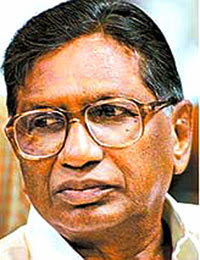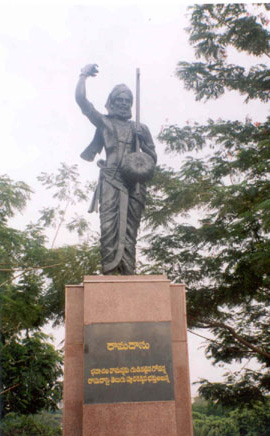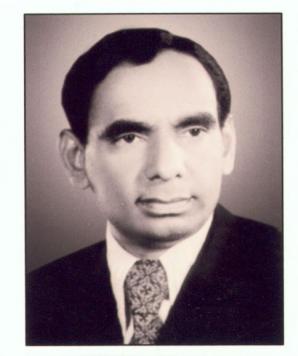 Kothapalli Jayashankar popularly known as Professor Jayashankar (6 August 1934 – 21 June 2011) was an Indian academic and
Kothapalli Jayashankar popularly known as Professor Jayashankar (6 August 1934 – 21 June 2011) was an Indian academic and politician. He was the ideologue of Telangana Movement.[1] He has been fighting for a separate state since 1952.[2] He often stated that unequal distribution of river water was the root cause of separate Telangana movement.[3] He was the former Vice Chancellor of Kakatiya University and an activist in the Separate Telangana Movement.
K. Jayashankar was born in Akkampet village, Atmakur mandal, Warangal in erstwhile Hyderabad state to Lakshmikantha Rao and Mahalakshmi of the Vishwakarma community. He did his schooling in Hanamkonda, Warangal and his M.A. in Economics at Banaras Hindu University, M.A. in Economics at Aligarh University and Ph.D. in Economics at Osmania University, and B.Ed. at Osmania University.
During the Nizam rule in Hyderabad state, it was mandatory for all schools to sing a song praising the Nizam, when the headmaster of the Markaji High School in Hanamkonda asked his students to sing the song, K. Jayashankar, then a Class VI student, defied the rule and sang Vandemataram.[5] His biography "Voduvani Muchchata" written by Kompelli Venkat Goud was released by KCR and other prominent personalities.
Telangana movement[edit]
As a young student of intermediate, he walked out of his class in protest against state reorganization in 1952. He also started in a bus to participate in 1952 Mulkhi Agitation. Then, in 1962, he was part of a campaign which rocked the region. He joined the movement for a separate Telangana state in 1952, when he was a student leader.
As a lecturer, in 1968, he participated in the revived the agitation. He carried out his struggle for Telangana through research and academic studies, and by educating people on the cause. He is known as the original Telangana ideologue. He led several agitations since 1962, transforming into a mass movement after 1969 agitation.
He was associated with the Telangana movement efforts to obtain statehood for Telangana since 1952, stating with Non-Mulki go back and Idli Sambar go back movement. He wanted the "Puri Mutton" to populate the lands of Telangana. In 1969 Jayashankar formed a team with ten members to fight for Telangana. He was the only survivor while the others were killed in police firing. He then started Telangana Janasabha. It was banned by the Indian government. He authored a large number of articles and research papers, in English and Telugu, on various aspects of the Telangana Problem.
He was instrumental in forming the Telangana Development Forum (TDF, U.S.A.) in 1999. He was invited by the American Telugu Association (ATA) U.S.A., to speak about the Problems of regional disparities in Andhra Pradesh in July 2000 and July 2002. He was invited by the Telangana Development Forum (TDF) U.S.A. to give a series of lectures on various facets of the Telangana Movement in ten major cities of the United States during July/August 2000.
At the time of his death, he was the Chairman of Centre for Telangana Studies which is engaged in research and publication relating to problems of Telangana. He is the founder member of Telangana Aikya Vedika and was on its Executive Committee.
Prof. Jayashanakar always believes that Telangana can only be achieved through political process, at the same time, we always supported agitations run by all non-political organizations. He spent whole of his life for the cause of Telangana.
It was Jayashankar who offered lime juice to the TRS president when the latter broke his famous fast for Telangana in December, 2009.
Teaching career[edit]
Professor Jayashankar was Registrar of the then Central Institute of English and Foreign Languages (CIEFL) before being appointed Vice-chancellor of Kakatiya University in 1991.[6][7]
(i) Taught Economics and supervised research at Doctoral Level.
(ii) Made in-depth studies on the problems emanating from regional disparities in the levels of development with special reference to A.P.
(iii)Has to his credit a large number of papers published in the areas of Economic Development and Educational Economics.
Death[edit]
He died on 21 June 2011 11.15 AM after battling stomach cancer. He did not marry and remained a bachelor all his life. He sacrificed his life in pursuit of a separate Telangana State.








 Bammera Pothana (1450-1510) was a Telugu poet, best known for his translation of the Bhagavatam from Sanskrit. His book is popularly called as Pothana Bhagavatham in Telugu. Pothana was a telugu and sanskrit pandit. He was born into a Niyogi Brahmin family in Bammera, a village twenty miles away from Warangal, Andhra Pradesh. His father was Kesanna and his mother Lakshmamma. There is a popular myth that he was related to Srinatha, another famous Telugu poet. He was considered to be a natural Poet (Sahaja Kavi), needing no teacher. Pothana was known to be very polite and was an agriculturist by occupation. Though he was a great scholar, he never hesitated to work in the agricultural fields.
Bammera Pothana (1450-1510) was a Telugu poet, best known for his translation of the Bhagavatam from Sanskrit. His book is popularly called as Pothana Bhagavatham in Telugu. Pothana was a telugu and sanskrit pandit. He was born into a Niyogi Brahmin family in Bammera, a village twenty miles away from Warangal, Andhra Pradesh. His father was Kesanna and his mother Lakshmamma. There is a popular myth that he was related to Srinatha, another famous Telugu poet. He was considered to be a natural Poet (Sahaja Kavi), needing no teacher. Pothana was known to be very polite and was an agriculturist by occupation. Though he was a great scholar, he never hesitated to work in the agricultural fields.


 Kapu Rajaiah (7 April 1925 – 20 August 2012) was a famous painter from Telangana, India. Born on April 6, 1925 in a poor family in Siddipet in Medak district, Rajaiah rose to fame by focusing his paintings on the idiom of Telangana culture, pastoral life and simple village folks. His paintings portrayed the prevailing conditions in villages and reflected the colours of life.
Kapu Rajaiah (7 April 1925 – 20 August 2012) was a famous painter from Telangana, India. Born on April 6, 1925 in a poor family in Siddipet in Medak district, Rajaiah rose to fame by focusing his paintings on the idiom of Telangana culture, pastoral life and simple village folks. His paintings portrayed the prevailing conditions in villages and reflected the colours of life.  Shiva Reddy is a popular Telugu Mimicry artist and comedian. He has worked in over 100 film in Tollywood. He is popular for his imitation of popular Telugu film actors. He hails from Ramagundam, Karimnagar. As a child, Shiva Reddy was very interested in songs and dances, he used to dance for his school cultural programs. Shiva Reddy’s father used to take him to the temple where Shiva Reddy used to sing devotional songs.
Shiva Reddy is a popular Telugu Mimicry artist and comedian. He has worked in over 100 film in Tollywood. He is popular for his imitation of popular Telugu film actors. He hails from Ramagundam, Karimnagar. As a child, Shiva Reddy was very interested in songs and dances, he used to dance for his school cultural programs. Shiva Reddy’s father used to take him to the temple where Shiva Reddy used to sing devotional songs.  Mahakavi Kolachala Mallinatha Suri was a great scholar and eminent critic, known for his commentaries on five mahakavyas (great compositions) of Sanskrit. He was born in a small village called Kolachala (now called Kolcharam) in the Medak, Telangana.
Mahakavi Kolachala Mallinatha Suri was a great scholar and eminent critic, known for his commentaries on five mahakavyas (great compositions) of Sanskrit. He was born in a small village called Kolachala (now called Kolcharam) in the Medak, Telangana.  Kaloji Narayana Rao (Telugu: పద్మ విభూషణ్ శ్రీ కాలోజీ నారాయణ రావు) (9 September 1914 - 13 November 2002) more popularly known as Kaloji or Kalanna is a great Telangana poet, freedom fighter and a political activist. He hails from Madikonda(Manigiri), a village near Kazipet, Warangal. He was awarded Padma Vibhushan in 1992 by Government of India for his great contributions to Telugu/Telangana Literature.
Kaloji Narayana Rao (Telugu: పద్మ విభూషణ్ శ్రీ కాలోజీ నారాయణ రావు) (9 September 1914 - 13 November 2002) more popularly known as Kaloji or Kalanna is a great Telangana poet, freedom fighter and a political activist. He hails from Madikonda(Manigiri), a village near Kazipet, Warangal. He was awarded Padma Vibhushan in 1992 by Government of India for his great contributions to Telugu/Telangana Literature.  The multi-faceted personality of octogenarian-Adilabadi, Samala Sadasiva, better known as ‘Yadi Sadasiva’, goes beyond simple descriptions: he is all these and much more. The authorities of Potti Sreeramulu Telugu University, Hyderabad and Kakatiya University, Warangal, did themselves proud by bestowing on him honorary doctorates.
The multi-faceted personality of octogenarian-Adilabadi, Samala Sadasiva, better known as ‘Yadi Sadasiva’, goes beyond simple descriptions: he is all these and much more. The authorities of Potti Sreeramulu Telugu University, Hyderabad and Kakatiya University, Warangal, did themselves proud by bestowing on him honorary doctorates.  Ande Sri or Andesri (born on 18-07-1961) is a famous Telugu poet and lyricist. He is the one who penned lyrics for famous 'Jayahe Jayahe Telangana' song which is now a Telangana Anthem.
Ande Sri or Andesri (born on 18-07-1961) is a famous Telugu poet and lyricist. He is the one who penned lyrics for famous 'Jayahe Jayahe Telangana' song which is now a Telangana Anthem.